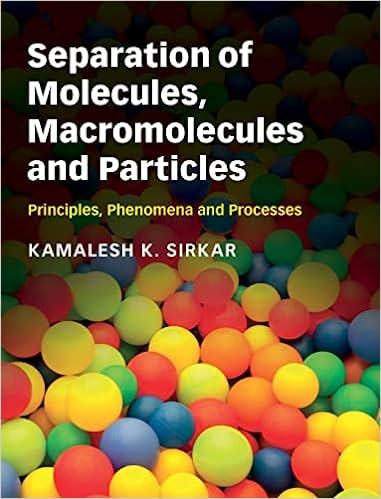Answered step by step
Verified Expert Solution
Question
1 Approved Answer
c ) A liquid fuel with a density of 8 6 3 kg m - 3 and a flow rate of 0 . 7 m
c A liquid fuel with a density of kg m and a flow rate of m s is to
be delivered by the operating pipeline of m long. The annual
charges interest on capital, maintenance and depreciation on the pipeline
are D per m length, where D is the pipe diameter in metres. The
design engineer overestimated the operating pipeline diameter by
from its optimum value What is the extra total annual cost linked to this
overestimation?
Darcy friction factor for the flow conditions in the pipe is x
Pipe length given is an equivalent length allowing for all fittings.
Pumping efficiency is
Cost of electricity for pumping is per kW per year.
g m s
The pipe is horizontal.
d The pipework system of a process is m long, m diameter and
includes valves and bends with the following characteristic:
Q m s H m fluid
utilising a centrifugal pump with impeller diameter m and running at
rev min for with following characteristics:
C H CQ CQ
where C H is the head coefficient and CQ is the flow coefficient.
i Determine the flow rate delivered and the pump operating head.
ii What would be the flow rate through the system if two such pumps were
connected firstly in series and secondly in parallel?
e The pump in the Figure is used to move water at C Given the
information below what is the maximum elevation, z of the pump to avoid
cavitation?
The NPSH required for this pump is m
Diameter of the pipe is mm
The flow rate is L s
The total losses are equal to velocity heads.
Atmospheric pressure, Patm is Pa
Vapour pressure of water at C PV is Pa
The density of water is kg m
The acceleration due to gravity, g is m s
Figure pump and tank diagram
a Describe and explain what information is needed to design an adsorption
process, for example recovering an antibiotic from solution in a bioreactor.
Include a comment on key features of an adsorbent make it desirable for
this process.
b A glass bottle containing a dilute solution of compound Z is sealed using
a rubber inverted square base pyramidal frustum of mm height see
Figure Over time Z will diffuse out of the bottle through the rubber.
The relationship between the distance from the top of the stopper y and
the distance x is given by:
x h a ytan theta
where x is half the width of the frustrum at any particular height, a is an
unknown constant and h is the height of the stopper.
i Calculate the rate of diffusion given the information in fig and
the data section for this question.
ii What key assumptions have you made to solve this problem?
DATA for part b:
x mm
x mm
theta deg
D times m s diffusivity of Z in rubber
C times kmol m concentration of Z in the rubber at yY
C kmol m concentration of Z in the rubber at yY
Figure : D view of rubber stopper leftD crosssection right
c A packed bed contains spheres of mm diameter. The spheres have
mm surface per mm of bed. Pure liquid is passed through the bed at
mm s After passing through mm of the bed it is saturated.
State the mass balance for this situation and then calculate the initial local
mass transfer coefficient in the column.
d Sketch a fully labelled diagram depicting the concentration profiles of a
diffusing species in the film theory approximation of the interface
between a gas and a liquid. Briefly state the key points of the model in
bullet point form
Step by Step Solution
There are 3 Steps involved in it
Step: 1

Get Instant Access to Expert-Tailored Solutions
See step-by-step solutions with expert insights and AI powered tools for academic success
Step: 2

Step: 3

Ace Your Homework with AI
Get the answers you need in no time with our AI-driven, step-by-step assistance
Get Started


